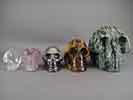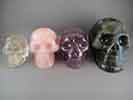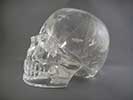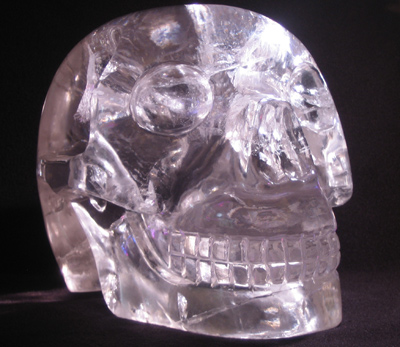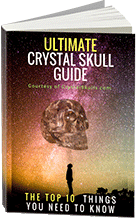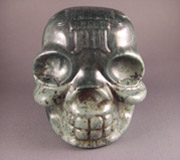THE DAY OF THE DEAD EXPLORED
Dia de los Muertos
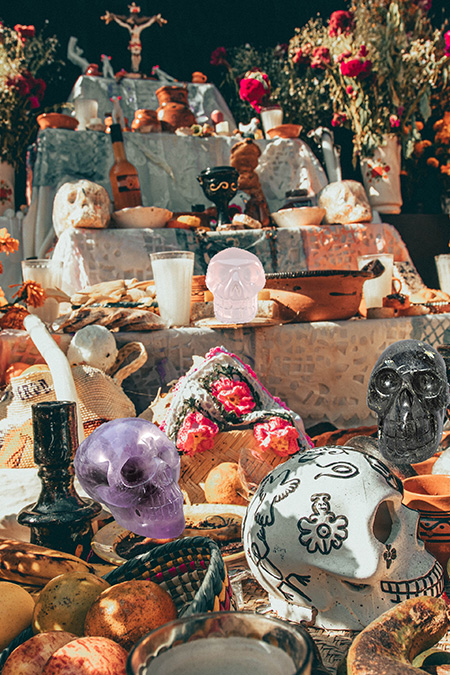
Día de los Muertos (“Day of the Dead” in English) has been a ritual for at least 3,000 years in central and southern Mexico. At that time, mourning the dead was seen as disrespectful. Instead of grieving, it was more important to keep the memory alive of loved ones who have passed. Those who celebrate this holiday believe that at midnight on October 31, the souls of deceased children come down from heaven and reunite with their families for the day of November 1st. They believe the souls of deceased adults come to visit on November 2nd.
The festivities surrounding Dia de los Muertos are filled with calaveras (skulls) and calacas (skeletons). Celebrants wear colorful makeup and costumes, hold parades and parties, sing and dance, and make offerings to lost loved ones. In honor of the dearly departed, people create altars decorated with pictures, flowers, candles, the deceased loved one's favorite food, and “pan de muerto” (bread of the dead), along with water in case they get thirsty on their journey between the worlds. Elaborately decorated skulls are placed on altars that are dedicated to the dead, and "Sugar Skulls" that have the names of the deceased person on the forehead are lovingly eaten by a relative or friend. Some people even incorporate real crystal skulls.
During the Day of Dead festivities, thousands of people take to streets wearing skull masks and dancing in honor of their deceased relatives. Despite the painted faces, costumes, skulls and skeletons, this holiday is not intended to be spooky like Halloween. While Halloween can be dark and scary, the Day of the Dead is a bright and colorful celebration.
Dia de los Muertos Skulls
Over 500 years ago, when Spanish Conquistadors landed in the Mayan Lands of what is now central Mexico, they encountered natives practicing a ritual that seemed to mock death. This ritual has been practiced for at least 3,000 years and although the Spaniards tried to eradicate it, it survived and is known today as Dia de los Muertos or Day of the Dead, which is celebrated November 1st, the day after North America's Halloween.
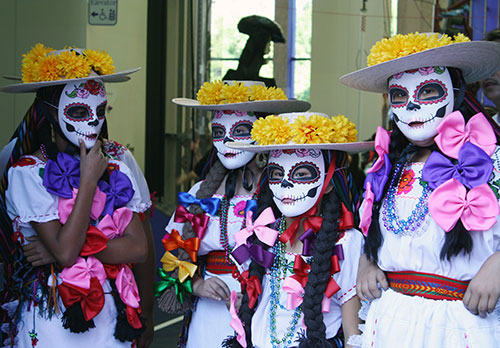
Dia de los Muertos honors the memory of deceased relatives and ancestors, however it is not a sombre event but one that is extremely colorful and festive. During the Day of Dead festivities, thousands of people take to streets wearing skull masks and dancing in honor of their deceased relatives. Elaborately decorated skulls are placed on altars that are dedicated to the dead, and "Sugar Skulls" made with the names of the dead person on the forehead are lovingly eaten by a relative or friend. Part of the Dia de los Muertos celebrations may include the drinking of Tequila, and at this time of year the decorative Skull Tequila bottles can be a favorite.
A genuine crystal skull can also be a more permanent symbol of remembrance. While crystal skulls are life-affirming, a "memorial" crystal skull honoring those who have transitioned to the Other Side can bring peace and solace, and can serve as a vessel to hold good memories and love associated with that special person. A crystal skull can also facilitate communion with your loved ones by opening channels to higher dimensions, whether in meditation or through heightened intuitive communication with higher realms.
People are often drawn to crystal skulls during times of major change and transition in their lives, particularly when a loved one passes... A Rose Quartz Crystal Skull is a particular favorite as it heals the heart of past and present pain. It is calming and fills us with love of those remembered. Amethyst Crystal Skulls are ideal for communicating with loved ones beyond the veil, and also facilitates communication with one’s guides, connection with the divine, and communion with higher realms of consciousness. For those seeking major positive transformation, a Nuummite Crystal Skull may serve as the ideal catalyst to propel forward and attract your desired future. |
Crystal Skulls
"Día de los Muertos (Day of the Dead) is a Mexican holiday in which individuals honor their dead loved ones by visiting their graves or having celebrations in their honor," writes Ellie Guzman on Medium. "For many it is deeply religious and is a source of comfort that those that have passed on are still loved and are with us spiritually."
Ancient traditions of the Day of the Dead celebrate life with skulls - not particulary death. Often used in fertility rites, and rites of passage including death, it was believed that old shaman would pass on their wisdom and knowledge to their successor through the crystal skull at the time of their death.
No one knows the true origin of the crystal skulls, many of which are believed to be thousands of years old. Some people believe that crystal skulls may have an extraterrestrial connection. What is extraordinary is that indigenous people all over the world, from Tibet, to the Navajo, to the Mayans all secretly share similar legends about crystal skulls and their gathering at a pivotal time in Earth's history.
David Carballo, visiting assistant professor in Anthropology at the University of West Georgia, says ancient cultures definitely could have made the skulls. "Meso-americans routinely polished statues and other artifacts out of jade, which is just as hard," he says. "Working those materials takes a lot of time, but all you need is a sand slurry and a lot of patience." (NY Post Article/Interview Apr 20, 2008)
Skulls for Celebration
As Halloween approaches, skulls are literally coming out of the woodwork and can be seen everywhere. Some people view skulls as a fearsome symbol of death, while ancient cultures have revered skulls as a symbol of eternal life and of consciousness itself. In Mexico, skulls will soon start to appear all over the country, not for Halloween but for the festival of Dia de los Muertos (Day of the Dead) where skulls are the main feature of a three-day celebration of life… and death.
Dia de los Muertos has been celebrated in Mexico since the 1500s, but its roots began with the Aztecs 3,000 years ago. It used to be held in August as part of a harvest festival, but Catholic influences moved it to November to coincide with All Saints Day and All Souls Day.
Psychic mediums say that the veil between the worlds of the living and the dead is thinnest on the night of Halloween (which was originally a sacred night called All Hallows' Eve), allowing our departed loved ones to more easily commune with us from "The Other Side" at that time. The festival of Dia de los Muertos is celebrated from October 31 to November 2, when it is believed that spirits return from the afterlife to reconnect with their loved ones. November 1st honors the souls of children who have passed away, called Angelitos (little Angels). November 2nd culminates with a celebration for the souls of adults as a way to remember loved ones and their contribution to the family.
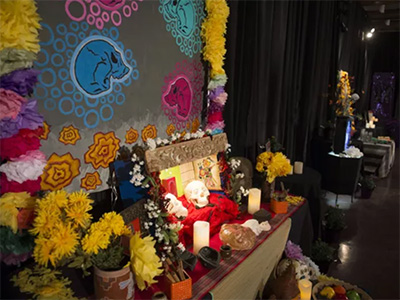
During the days leading up to the festival, families build altars in their homes and throughout the city streets. These altars usually include a photograph of the departed as well as seven steps filled with symbols and gifts left for the loved one, including some of their favorite things that they enjoyed in life as a way to welcome them home. Most altars will include candles, colorfully decorated skulls made of sugar known as “sugar skulls”, and pan de muerto – a sweet bread often made into the shape of skulls and bones. During the festival, skull images appear everywhere and people paint their faces to look like skulls.
It is a celebration of the cycle of life as the soul lasts forever. In Mexican culture, it is taught that when a person dies all that remains is the bones, so the soul resides in the bones, which are venerated beyond death. During the Dia de los Muertos festivities, cemeteries are full of revelers having moonlight picnics at the graves of their loved ones, and parading through the streets dressed as skeletons and wearing skull faces. Death is celebrated, not feared, because the souls and the memories live on through generations. |
"Hello lovely skull people! Firstly I would like to say how magikal are all the skulls I have bought from you over the years. It is wonderful to be able to trust your integrity."(read more testimonials)
|
History: Ritual dates back 3,000 years and is still evolving
Top 10 Things to Know About the Day of the Dead
When Death Doesn’t Mean Goodbye
REMEMBERING THE DEAD
Visiting Mexico & Celebrating Life and Death
USA Day of the Dead Tradition
You could even acquire your very own real crystal skull: from a $20 pocket-size quartz crystal skull, to a $22,000 ultra clear life-size new crystal skull.
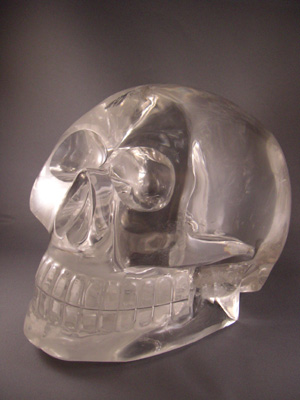
Sugar Skulls
In North America, many people have family traditions around decorating for Halloween, which was originally known as All Hallow's Eve. In Mexico, part of the tradition for the November 1st "Dias de los Muertos" (Day of the Dead) is the creation of Sugar Skulls - these are edible (and non-edible) skulls usually made of meringue and sugar, colorfully decorated. As part of the feast to honor the ancestors, the Sugar Skulls bear the name of a loved one that has crossed over. Dia De Los Muertos is a 2-day celebration of life that takes place each year on November 1st and 2nd, when families reunite in a joyous and colorful remembrance of lost loved ones.
The ingredients for Sugar Skulls are very simple, yet the creation may pose a challenge to some, especially without the right meringue powder or if you live in a humid climate that would not allow for the ingredients to bond properly. The decoration itself is left up to your imagination which is mainly sugar icing - in lots of colors. Of course you can add on non-edible items like foil and sparkles to continue decorating the Sugar Skull.
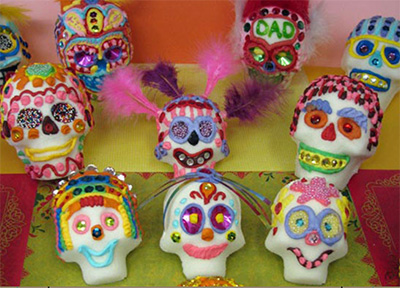
While it may be tempting to eat the Sugar Skulls, experts state that eating a big hunk of granulated sugar and Royal Icing is not a tasty or particularly pleasant experience! Sugar skulls are more a folk art - serving as a dedication to a loved one. You can join the celebration with these step-by-step instructions on how to make Sugar Skulls - which includes the recipe, important tips, and where to find the best ingredients. Sugar skulls can be a fun activity for the whole family, even for Halloween.
Related Weblinks:
Sugar Skull Instructions : https://mexicansugarskull.com/pages/sugar-skull-making-instructions
Sugar Skulls Video & Molds : https://www.youtube.com/watch?v=g2dUbXiFydg
Sugar Skull Decorating Ideas: https://www.art-is-fun.com/how-to-decorate-sugar-skulls
The Meaning and Importance of Sugar Skulls: https://dayofthedead.holiday/sugar-skull/the-meaning-and-importance-of-sugar-skulls
The Day of the Dead : https://crystalskulls.com/day-of-the-dead.html
|
"I received my skulls(4) and love them. They're all so different in their own way. 15 of my family members and I traveled to Mexico just after Christmas and we went to the Chichenitza. We learned about the ruins and the story of the crystal skulls. I was so intrigued by it that I began researching the skulls when I got home. I came accross your website and I'm glad I did. My plan is to purchase the same skull necklace for each of the girls that were on the trip. So far I have the 4 and I'm going to buy 7 more. Thank You.""(read more testimonials)
|
Cinco de Mayo is not Skull Related
Cinco de Mayo and Día de los Muertos
are separate holidays.
"Día de los Muertos (Day of the Dead) is a Mexican holiday in which individuals honor their dead loved ones by visiting their graves or having celebrations in their honor," writes Ellie Guzman on Medium. "For many it is deeply religious and is a source of comfort that those that have passed on are still loved and are with us spiritually."
Día de los Muertos is held on Nov. 1.
It is entirely different from Cinco de Mayo, which is a commemoration of General Ignacio Zaragoza's victory over much better equipped French military forces at the Battle of Puebla in 1862. The foreign forces, sent by Napoleon III, were attempting to set up a French-controlled client state in Mexico. In part because the U.S. has a large Mexican-American population, and in part because the U.S. loves commercially lucrative holidays, Cinco de Mayo is celebrated to a much greater extent stateside than in the actual country of Mexico.
So yes, the skull makeup and costumes... are for an entirely different holiday than Cinco de Mayo.
Cinco de Mayo is also not the same thing as Mexican Independence Day, which is in September and happened more than 50 years before the Battle of Puebla.
You don't need to be knowledgeable about Mexican history to drink a few margaritas or hang out at a Mexican restaurant. But if you intend to celebrate Mexican and Mexican-American culture on May 5, you should probably be aware of the very general basics of the holiday you're celebrating. Wearing skull makeup on Cinco de Mayo would be like shooting off red, white and blue fireworks on Halloween.
Courtesy Source |
Further exploration
Does Dias de los Muertos ( Day of the Dead ) compare to Memento Mori tradition? - and how are crystal skulls featured.

|

